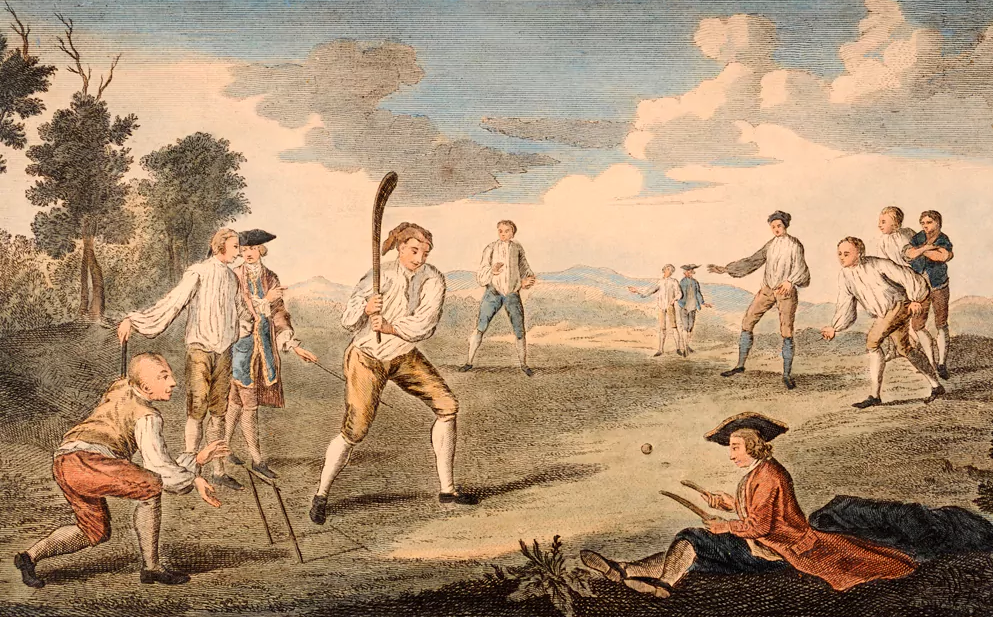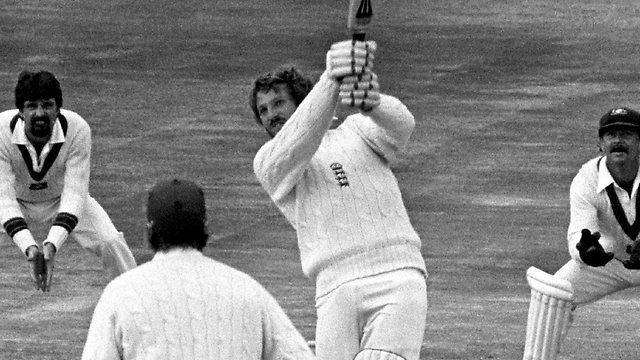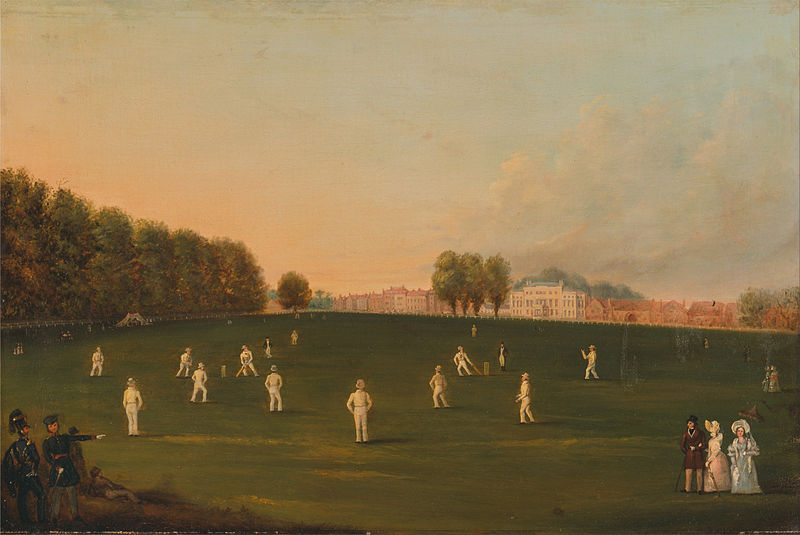Story Of CRICKET
The origins of cricket lie somewhere in the Dark Ages - probably after the Roman Empire, almost certainly before the Normans invaded England, and almost certainly somewhere in Northern Europe. All research concedes that the game derived from a very old, widespread and uncomplicated pastime by which one player served up an object, be it a small piece of wood or a ball, and another hit it with a suitably fashioned club.

Early days
Cricket was first recorded in 16th-century England, and it was played in grammar schools, farm communities and everywhere in between. But things really took off when 18th-century nobles realised that not only was it a great sport but also an excellent opportunity for betting.
With sky-high stakes being wagered, it was deemed necessary to come up with agreed rules. The oldest surviving set of cricket laws date from 1744 – printed on a handkerchief, naturally. It's now in the MCC Museum at Lord’s in London.
The oldest permanent fixture is the annual Eton v Harrow match, played since 1805. A young Lord Byron turned out for Harrow in the first match, though history doesn't record how poetic – or “mad, bad and dangerous” – his bowling was.
The first international match was in 1877 when Australia beat England in Melbourne. The match was dubbed a “Test”, since the gruelling nature of playing over five days was deemed the ultimate “test” for any side.
But it was Australia’s first win on English soil – in 1882 at The Oval in London – that led to matches between the two nations being christened the Ashes. Following the defeat, newspapers published an obituary mourning “the death of English cricket”, adding that “the body will be cremated and the ashes taken to Australia”.
Great players
Cricket’s earliest star was WG Grace, who played 44 seasons from 1865 to 1908. Despite the game’s reputation as the epitome of fairness, Grace was as famous for his gamesmanship as his batting. He once ran three, then when the ball was flung in from the outfield, caught it, put it in his pocket and ran three more.
The top batsman in history is India’s Sachin Tendulkar, who retired in 2013 after scoring 15,921 runs in 200 Tests and 18,426 in 463 one-day internationals. He is the only player to have made 100 international centuries, was the first batsman to score a double century in a one-day International and is the only player to amass more than 30,000 international runs.
A special mention must go to West Indies' legend Sir Garfield (Gary) Sobers, who became the first batsman to hit six sixes in a single over off six consecutive balls in first-class cricket, playing for Nottinghamshire against Glamorgan in 1968.

Legendary matches
Perhaps the most famous match in English history was the third Test against Australia at Headingley in 1981. England were made to follow on and, with wickets falling fast in their second innings, were given odds of 500-1 to win the match.
But a gung-ho second-innings 149 from Ian Botham, followed by eight wickets for 43 runs from Bob Willis, turned the match on its head and earned england an 18-run victory. It was the first time in 104 years of Test history that a side had won a match after following on.
Super stats
The fastest ball bowled was 161.3 km/h (100.23mph) by Shoaib Akhtar for Pakistan against England in a 2003 World Cup match in South Africa.
The longest Test innings by a batsman was 970 minutes – more than 16 hours – by Hanif Mohammad, when scoring 337 for Pakistan against the West Indies in 1958. Mohammad claimed he actually batted for 999 minutes.
The highest individual Test score is West Indies batsman Brian Lara’s 400 not out against England in Antigua in 2004. Lara also made the highest first-class score of 501 not out for Warwickshire against Durham at Edgbaston in 1994. The highest first class total is 1,107 hit by Victoria against New South Wales in 1926. By contrast, the lowest total is the miserable 12 scored by Northants playing Gloucester in 1907.

Dates in cricket history
1550 (approx) Evidence of cricket being played in Guildford, Surrey.
1598 Cricket mentioned in Florio's Italian-English dictionary.
1610 Reference to "cricketing" between Weald and Upland near Chevening, Kent. 1611 Randle Cotgrave's French-English dictionary translates the French word "crosse" as a cricket staff.
Two youths fined for playing cricket at Sidlesham, Sussex.
1624 Jasper Vinall becomes first man known to be killed playing cricket: hit by a bat while trying to catch the ball - at Horsted Green, Sussex.
1676 First reference to cricket being played abroad, by British residents in Aleppo, Syria.
1694 Two shillings and sixpence paid for a "wagger" (wager) about a cricket match at Lewes.
1697 First reference to "a great match" with 11 players a side for fifty guineas, in Sussex.
1700 Cricket match announced on Clapham Common.
1709 First recorded inter-county match: Kent v Surrey.
1710 First reference to cricket at Cambridge University.
1727 Articles of Agreement written governing the conduct of matches between the teams of the Duke of Richmond and Mr Brodrick of Peperharow, Surrey.
1729 Date of earliest surviving bat, belonging to John Chitty, now in the pavilion at The Oval.
1730 First recorded match at the Artillery Ground, off City Road, central London, still the cricketing home of the Honourable Artillery Company.
1744 Kent beat All England by one wicket at the Artillery Ground.
First known version of the Laws of Cricket, issued by the London Club, formalising the pitch as 22 yards long.
1767 (approx) Foundation of the Hambledon Club in Hampshire, the leading club in England for the next 30 years.
1769 First recorded century, by John Minshull for Duke of Dorset's XI v Wrotham.
1771 Width of bat limited to 4 1/4 inches, where it has remained ever since.
1774 LBW law devised.
1776 Earliest known scorecards, at the Vine Club, Sevenoaks, Kent.
1780 The first six-seamed cricket ball, manufactured by Dukes of Penshurst, Kent.
1787 First match at Thomas Lord's first ground, Dorset Square, Marylebone - White Conduit Club v Middlesex.
Formation of Marylebone Cricket Club by members of the White Conduit Club.
1788 First revision of the Laws of Cricket by MCC.
1794 First recorded inter-schools match: Charterhouse v Westminster.
1795 First recorded case of a dismissal "leg before wicket".
1806 First Gentlemen v Players match at Lord's.
1807 First mention of "straight-armed" (i.e. round-arm) bowling: by John Willes of Kent.
1809 Thomas Lord's second ground opened at North Bank, St John's Wood.
1811 First recorded women's county match: Surrey v Hampshire at Ball's Pond, London.
1814 Lord's third ground opened on its present site, also in St John's Wood.
1827 First Oxford v Cambridge match, at Lord's. A draw.
1828 MCC authorise the bowler to raise his hand level with the elbow.
1833 John Nyren publishes his classic Young Cricketer's Tutor and The Cricketers of My Time.
1836 First North v South match, for many years regarded as the principal fixture of the season.
1836 (approx) Batting pads invented.
1841 General Lord Hill, commander-in-chief of the British Army, orders that a cricket ground be made an adjunct of every military barracks.
1844 First official international match: Canada v United States.
1845 First match played at The Oval.
1846 The All-England XI, organised by William Clarke, begins playing matches, often against odds, throughout the country.
1849 First Yorkshire v Lancashire match.
1850 Wicket-keeping gloves first used.
1850 John Wisden bowls all ten batsmen in an innings for North v South.
1853 First mention of a champion county: Nottinghamshire.
1858 First recorded instance of a hat being awarded to a bowler taking three wickets with consecutive balls.
1859 First touring team to leave England, captained by George Parr, draws enthusiastic crowds in the US and Canada.
1864 Overhand bowling authorised by MCC.
John Wisden's The Cricketer's Almanack first published.
1868 Team of Australian aborigines tour England.
1873 WG Grace becomes the first player to record 1,000 runs and 100 wickets in a season.
First regulations restricting county qualifications, often regarded as the official start of the County Championship.
1877 First Test match: Australia beat England by 45 runs in Melbourne.
1880 First Test in England: a five-wicket win against Australia at The Oval.
1882 Following England's first defeat by Australia in England, an "obituary notice" to English cricket in the Sporting Times leads to the tradition of The Ashes.
1889 South Africa's first Test match.
Declarations first authorised, but only on the third day, or in a one-day match.
1890 County Championship officially constituted.
Present Lord's pavilion opened.
1895 WG Grace scores 1,000 runs in May, and reaches his 100th hundred.
1899 AEJ Collins scores 628 not out in a junior house match at Clifton College, the highest individual score in any match.
Selectors choose England team for home Tests, instead of host club issuing invitations.
1900 Six-ball over becomes the norm, instead of five.
1909 Imperial Cricket Conference (ICC - now the International Cricket Council) set up, with England, Australia and South Africa the original members.
1910 Six runs given for any hit over the boundary, instead of only for a hit out of the ground.
1912 First and only triangular Test series played in England, involving England, Australia and South Africa.
1915 WG Grace dies, aged 67.
1926 Victoria score 1,107 v New South Wales at Melbourne, the record total for a first-class innings.
1928 West Indies' first Test match.
AP "Tich" Freeman of Kent and England becomes the only player to take more than 300 first-class wickets in a season: 304.
1930 New Zealand's first Test match.
Donald Bradman's first tour of England: he scores 974 runs in the five Ashes Tests, still a record for any Test series.
1931 Stumps made higher (28 inches not 27) and wider (nine inches not eight - this was optional until 1947).
1932 India's first Test match.
Hedley Verity of Yorkshire takes ten wickets for ten runs v Nottinghamshire, the best innings analysis in first-class cricket.
1932-33 The Bodyline tour of Australia in which England bowl at batsmen's bodies with a packed leg-side field to neutralise Bradman's scoring.
1934 Jack Hobbs retires, with 197 centuries and 61,237 runs, both records. First women's Test: Australia v England at Brisbane.
1935 MCC condemn and outlaw Bodyline.
1947 Denis Compton of Middlesex and England scores a record 3,816 runs in an English season.
1948 First five-day Tests in England.
Bradman concludes Test career with a second-ball duck at The Oval and a batting average of 99.94 - four runs short of 100.
1952 Pakistan's first Test match.
1953 England regain the Ashes after a 19-year gap, the longest ever.
1956 Jim Laker of England takes 19 wickets for 90 v Australia at Manchester, the best match analysis in first-class cricket.
1957 Declarations authorised at any time.
1960 First tied Test, Australia v West Indies at Brisbane.
1963 Distinction between amateur and professional cricketers abolished in English cricket.
The first major one-day tournament begins in England: the Gillette Cup.
1969 Limited-over Sunday league inaugurated for first-class counties.
1970 Proposed South African tour of England cancelled: South Africa excluded from international cricket because of their government's apartheid policies.
1971 First one-day international: Australia v England at Melbourne.
1975 First World Cup: West Indies beat Australia in final at Lord's.
1976 First women's match at Lord's, England v Australia.
1977 Centenary Test at Melbourne, with identical result to the first match: Australia beat England by 45 runs.
Australian media tycoon Kerry Packer, signs 51 of the world's leading players in defiance of the cricketing authorities.
1978 Graham Yallop of Australia wears a protective helmet to bat in a Test match, the first player to do so.
1979 Packer and official cricket agree peace deal.
1980 Eight-ball over abolished in Australia, making the six-ball over universal.
1981 England beat Australia in Leeds Test, after following on with bookmakers offering odds of 500 to 1 against them winning.
1982 Sri Lanka's first Test match.
1991 South Africa return, with a one-day international in India.
1992 Zimbabwe's first Test match.
Durham become the first county since Glamorgan in 1921 to attain firstclass status.
1993 The ICC ceases to be administered by MCC, becoming an independent organisation with its own chief executive.
1994 Brian Lara of Warwickshire becomes the only player to pass 500 in a firstclass innings: 501 not out v Durham.
2000 South Africa's captain Hansie Cronje banned from cricket for life after admitting receiving bribes from bookmakers in match-fixing scandal.
Bangladesh's first Test match.
County Championship split into two divisions, with promotion and relegation.
The Laws of Cricket revised and rewritten.
2001 Sir Donald Bradman dies, aged 92.
2003 Twenty20 Cup, a 20-over-per-side evening tournament, inaugurated in England.
2004 Lara becomes the first man to score 400 in a Test innings, against England.
2005 The ICC introduces Powerplays and Supersubs in ODIs, and hosts the inaugural Superseries.
2006 Pakistan forfeit a Test at The Oval after being accused of ball tampering.